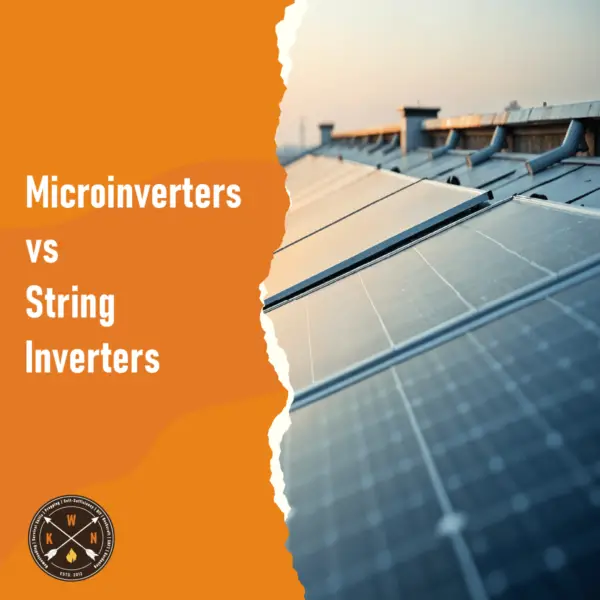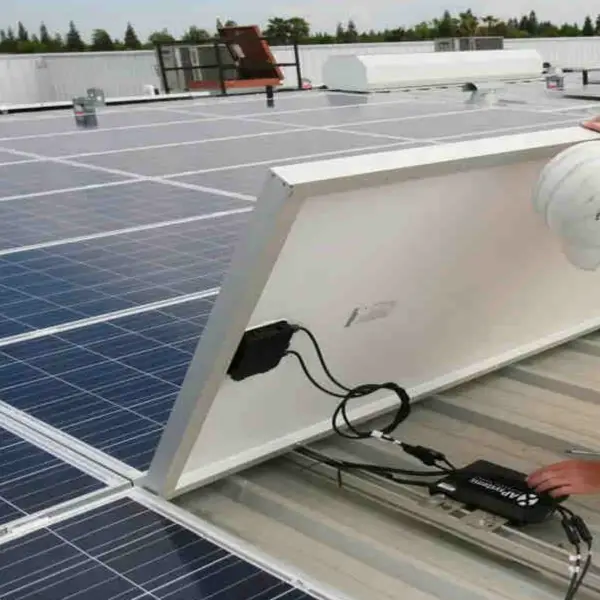
Thinking about solar power? Choosing the right solar inverter can be tough. You’re probably wondering if microinverters vs string inverters are really that different. It may feel like figuring out a complicated puzzle, but knowing which type fits your needs makes the process worthwhile.
Table of Contents
ToggleUnderstanding Solar Inverters: Microinverters vs String Inverters
Solar panels create direct current (DC) electricity. Most homes use alternating current (AC) electricity. Solar inverters, specifically, solar inverters convert the DC electricity into AC electricity. Selecting the correct type impacts how well your system works and how much it costs. There are advantages and disadvantages to each.

What Are String Inverters?
String inverters hook up several solar panels in a series, or a “string”. The inverter, inverter installed close to your electrical panel, converts all of this energy from DC to AC. They’re a straightforward, affordable way to handle solar power conversion for your solar systems.
String inverters work best when your solar panels all get equal sunlight. Simple, unshaded roofs are great for this setup. For many years, companies have used string inverters to reliably create solar power from panels that can be wired together.
String Inverter Advantages
- Lower Cost: Typically, the costs of solar panels will be kept reasonable thanks to the lower cost of string inverters.
- Simple Setup: Fewer parts lead to simpler, quicker solar installations.
- Easy Troubleshooting: Having only one inverter makes finding and fixing problems easier.
String Inverter Disadvantages
One issue with string inverters involves shade. Shaded solar panels can lower the performance of others wired to them. Also, they generally have shorter warranties compared to microinverters.
- Shading Problems: Shade on even one panel lowers the entire string’s energy output.
- Less Expandable: Adding more panels might require a new inverter, increasing costs.
- Shorter Warranties: String inverters typically come with shorter warranties, whereas detailed monitoring is not always available.
What Are Microinverters?
Microinverters connect to each panel individually, converting DC to AC right on your roof. This setup lets each panel perform at its best. Shading or other issues on one panel won’t drag down the others, letting your solar power energy production reach its full capacity.
Microinverter Advantages
Microinverters have advantages when it comes to maximizing the performance of your solar energy setup. Each panel works independently, which means better production for complex roofs, that might include situations of shading and different panel orientations.
- Better Performance: Individual panel performance is key because one shaded panel doesn’t affect the others.
- Easy Expansion: Want to add panels later? Micro inverters, from the Enphase IQ8 series, let you expand without needing a new inverter.
- Longer Warranties: Get peace of mind with longer warranties that can meet the lifespan of panels themselves.
Microinverter Disadvantages
Microinverters also come with potential downsides for your solar installation. They tend to be more expensive than string inverters, because there is additional equipment. You might find that solar panels cost you more upfront.
- Higher Upfront Cost: Costs can add up since you need one microinverter per panel.
- More Parts to Fail: Though reliable, having more inverters means more potential points of failure.
microinverters vs string inverters: Performance in Real-World Conditions
Many factors, including shade, affect which inverter performs best. String inverters work best in unshaded conditions. Microinverters win when shade or complicated roof layouts are involved according to microinverters vs analysis, enabling maximum panel performance.
Shading and Obstructions
Shade can significantly affect string inverter performance. If one panel in a string gets shade, the whole string’s output drops. Microinverters bypass this since each panel works on its own.
With string inverter efficiency, some studies show there are no performance advantages between the two. You might want to carefully consider if power optimizers would benefit your configuration, if using string inverters.
Roof Orientation and Complexity
Complex roofs also pose problems for string inverters. Different roof sections might face various directions, capturing varied amounts of sunlight. Here is a deeper look at each of the options in detail.
- String inverters require all panels in a string to face the same direction for peak output.
- Microinverters allow panels on different roof sections to operate independently.
Expansion Capabilities
Micro-inverters give you room to grow or if you plan to start small and add solar panels later. String inverters might require a total system overhaul to be useful.
Reliability and Warranty: What to Expect
Reliability is essential for a solar system because they usually are massive projects. Both string inverters and microinverters have different lifespans and warranty options that you should carefully consider for your panels cost.
Lifespan and Failure Rates
The lifespan and reliability of inverters can greatly influence a system’s long-term performance. String inverters have a 10 year warranty period on average.
There is evidence of low microinverter failure rates as little as 0.05%, which is much lower than string inverters.
However, string inverters’ failure rates are about 0.5 to 2%. A study shows that number might increase up to 34.3% after 15 years, a large gap. String inverters also see failures rise a lot over time.
Warranty Comparison
Warranties provide financial safety if an inverter fails, so panel monitoring and solar power performance remains consistent for a long time. The length and coverage determine your potential repair or replacement costs.
The most popular microinverters come with a warranty of 5-10 years with an estimated life of 20-25 years. Because of this, there is an expected increase in lifespan that comes from switching from one to the other.
String inverters generally have shorter warranty periods than the panels themselves.
Cost Analysis: Making an Informed Decision About your Inverter Types
Upfront costs and long-term savings matter when picking a solar power system. Microinverters usually cost more at first because there are multiple components to keep an eye on. You’re paying more to add solar, because you are investing in individual solar panel monitoring and maximized production, particularly if shading is an issue.
Initial Investment
Assess your finances when choosing your panels cost. A smaller budget might push you toward string inverters. Remember, you may lose money overall because the entire panel system production hinges on a string.
Higher initial investment usually happens when you need optimized panel performance, especially for complex roofs.
Long-Term Savings
Also, it is important to factor in possible higher energy production. Microinverters often provide better long-term savings. Think about what add solar options will yield over time.
Maintenance and Replacement Costs
Maintenance costs matter as time passes. Consider repair ease and potential replacement expenses. Here are a few things to keep in mind about main types.
- String inverters are easy to access for repairs because they are installed close to your main service panel.
- Replacing microinverters, inverters microinverters, means technicians have to access individual panels. This also leads to higher costs because of complexity.
Solar Inverter Brands and Technology
Picking the correct brand assures your solar installation performs to the best of its abilities. Enphase, SolarEdge and other big names offer advanced solar inverter technology.
Enphase
Enphase focuses on microinverters, panel monitoring, giving homeowners detailed performance data. Because their panels operate individually, if you had panel issues, you would only have to get service on those ones.
SolarEdge
SolarEdge uses power optimizers alongside string inverters. The use of solar optimizers enhances system performance and improves panel-level monitoring. Some benefits might also include that individual panel performance does not affect other panels.
Hybrid Inverters and Battery Storage
Integrating battery storage creates energy independence because energy produced is captured and reused rather than lost. Solar battery storage capability gives you continuous power during outages, by using converted dc power in efficient ways.
How Hybrid Inverters Work
A hybrid inverter connects your solar panels, solar batteries, grid, and home, streamlining energy management in the most effective way. Solar panels gain full connectivity in every way. They effectively make all connected things act as a whole for energy optimization.
Choosing the Right Inverter for Battery Storage
Pick an inverter that fits your solar batteries perfectly. Talk with installers or electricians so that your entire energy ecosystem works harmoniously. Compatibility matters when adding or planning for back up capabilities.
Installation Considerations for your Residential Solar Power
Proper solar installations assures that your whole array works efficiently, no matter the solar inverters. Experienced installers consider the different requirements between string inverters and microinverters to guarantee top-tier production. When getting yours set up, factor in your roof’s condition, the wiring needs, and placement considerations to improve energy output.
Improper string inverter installations will result in suboptimal panel performance. Getting solar panels for home, calls for optimized AC power.
Complexity of Installation
String inverters need to be set up only next to your main service panel. Microinverters attach individually to all of the panels and require more time and skill to be done correctly and effectively.
Safety Requirements
All solar set ups must follow safety standards. Microinverters operate at low voltages which enhance the system’s safety by eliminating high-voltage DC wiring.
Long-Term Maintenance
Easily accessible inverters facilitate faster and lower maintenance in the long term. Planning the system layout assures convenient access.
In-Depth Comparison Table
Here’s a detailed table to help you compare microinverters and string inverters based on various factors:
| Feature | String Inverters | Microinverters |
|---|---|---|
| Cost | Lower initial cost | Higher initial cost |
| Performance in Shade | Significantly reduced output | Minimal impact |
| Roof Complexity | Best for simple, unshaded roofs | Suitable for complex roofs with varying orientations |
| Expansion | May require system overhaul | Easy to expand |
| Lifespan | Typically shorter | Typically longer |
| Warranty | Shorter warranty periods | Longer warranty periods |
| Maintenance | Easier access for repairs | More complex, as inverters are on the roof |
| Monitoring | Basic system-level monitoring | Individual panel monitoring |
| Safety | High-voltage DC wiring | Low-voltage DC wiring |
| Battery Storage | Requires compatible hybrid inverter | Requires compatible microinverter system |
FAQs about microinverters vs string inverters
Is a microinverter better than a string inverter?
Whether a microinverter is “better” than a string inverter depends on the specific needs and conditions of your solar installation. Consider factors such as shading, roof orientation, system expansion plans, and budget to determine which inverter type is more suitable for your situation.
What are the disadvantages of microinverters?
Some cons with microinverters come from the higher cost initially. They have more components to worry about. Additionally, installations become more time consuming.
What is the failure rate of Enphase microinverters?
While the actual rate can fluctuate, a number of reports share how dependable these are over time. There is evidence to support failure rates as low as 0.05%.
Are micro inverters any good?
Yes, microinverters are a good choice, especially for solar installations that experience shading, have complex roof layouts, or require individual panel monitoring. They maximize energy production and offer flexibility for future system expansions. Also, a bonus benefit to that is panel monitoring capabilities on individual panels that can give insight to issues that occur on certain sections of panels.
Conclusion
Selecting the proper solar inverters is all about balancing output, stability, and expense. As technology gets better, considering the complexities of your house and power demands makes sure that you put money into the best system that fully takes advantage of what the sun provides. Thinking carefully, whether deciding for microinverters vs string inverters assures sustainable energy transformation.

